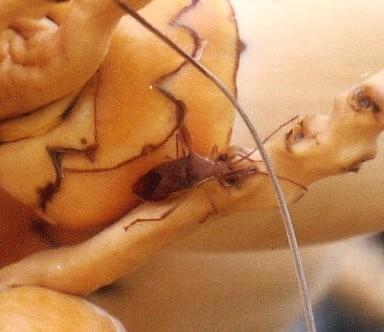


Adult coconut bug (Pseudotheraptus wayi)
The coconut bug (Pseudotheraptus wayi) is the most important pest of coconuts in East Africa. A related species of coconut bug, Pseudotheraptus devastans, causes similar damage to coconuts in West Africa.
Adult bugs are brown in colour and 1.2 to 1.4 cm long. They lay eggs singly on the flowers or young nuts. Nymphs are red brown to green brown in colour and have long antenna. Adults and nymphs suck on flowers and developing fruits causing flower abortion and early nutfall. The toxic saliva of the bugs causes necrotic sunken lesions (scars) and cracks on the nuts.
Attacked young nuts excrete gum. Many of the attacked young nuts fall off. Nuts older than 3 months at the time of attack may not be aborted but remain small and have scars. Yield losses are difficult to assess since many of the nuts (over 70%) fall naturally. Nuts which abort naturally, do not show scars or gummosis. Two bugs per palm can cause considerable damage. Damage is usually less serious in intercropped coconuts. The bugs also feed on cashew, mango, cocoa and guava.
The predatory red weaver ant is an efficient natural enemy of the coconut bug. Weaver ants build nests on palms and other trees by joining leaves with silk produced by their larvae. They forage on the canopy chasing away or killing coconut bugs. Palms with weaver ants are usually free of damage by the coconut bug. Good control is achieved when more than 60% palms are occupied by thriving colonies of weaver ants. Unfortunately other ants present in coconut plantations fight weaver ants, and themselves do not protect (or not as effective as weaver ants) the palms against coconut bugs. These ants such as big headed ant (Pheidole megacephala), the crazy ant (Anoplolepis custodiens), and the long legged ant (Anoplolepis longipes) among others, kill or displace weaver ants, as a result palms are severely damaged. These competing or antagonistic ants need to be managed to allow weaver ants to do their beneficial work.
- Keep bushes and trees that are hosts for weaver ants in the surrounding of coconut fields.
- Intercrop coconuts with plants favoured by weaver ants such as citrus, soursop, guava, mango, etc
- In areas where the big headed ant is dominant keep ground vegetation. If there were no ground vegetation this ant would be forced to search food on the trees and would displace weaver ants.
- Connect the canopy of neighbouring palms/trees with sticks, wire, or ropes. Weaver ants can easily walk among trees searching for food and set up new nests avoiding other ants active on the ground.
- Where weaver ants are not present transfer weaver ant nests into the field by collecting nests from bushes around and placing them onto coconut palms or other host plants in the field. Care should be taken not to mix ants from different colonies since they would fight. Do not place nests collected from different trees or trees far apart on the same trees since they are likely to belong to different colonies and will kill each other. The best time for collection of nests is during the rainy season, since in this period many new queens are present in the ant nests, and these may get established in the orchard and start new colonies. Ants in nests introduced without the queen will die out after some time (they may live up to 8 months) and new introductions are needed.
